Serviços Personalizados
Journal
Artigo
Indicadores
-
 Citado por SciELO
Citado por SciELO -
 Acessos
Acessos
Links relacionados
-
 Similares em
SciELO
Similares em
SciELO
Compartilhar
Tourism & Management Studies
versão impressa ISSN 2182-8458
TMStudies vol.11 no.1 Faro jan. 2015
TOURISM – RESEARCH PAPERS
Raising cultural awareness of local traditions through festival tourism
A sensibilização cultural das tradições locais através do turismo de festivais
Mariya Stankova1; Ivanka Vassenska2
1South-West
University "Neofit Rilski", Faculty of Economics, Department of
Tourism, 2 Krali-Marko Str., Blagoevgrad 2700, Bulgaria, mstankova@swu.bg
2South-West
University "Neofit Rilski", Faculty of Economics, Department of
Tourism, Blagoevgrad 2700, Bulgaria, ivankav@abv.bg
ABSTRACT
Worldwide, festivals and local special events are used as key elements within regional development strategies. Festivals and local special events are widely acknowledged to make an important contribution to the economic development of their local areas, as they provide opportunities for tourism promotion, commercial outcomes and increased inward investment in host regions (Getz, 2007; Van de Wagen, 2005) and contribute to the extension of the tourism season (Huang, Li & Cai, 2010; Boo and Busser, 2006; Kotler, Haider & Rein, 1993; Mehmetoglu and Ellingsen, 2005). However, the question of their contribution to the conservation of cultural heritage and traditions through an interpretation in tourism also requires attention.
In the paper, the approach of cultural profiles is implemented as a tool to raise the awareness for local tradition, being presented on local festival. In this regard, based on a survey among organizers of festivals, local entrepreneurs participating in festivals and tourists visiting them, the degree of authenticity of local traditions in South Bulgaria was estimated. With the main purpose – identification and establishment of opportunities for sustainable economic, social and cultural development of those regions, preserving and handing the existing heritage to future generations.
Keywords: Festivals, festival tourism, local products, traditions, cultural awareness.
RESUMO
Em todo o mundo, festivais e eventos especiais locais são usados como elementos-chave no âmbito das estratégias de desenvolvimento regional. Festas e eventos especiais locais são amplamente reconhecidos como dando um importante contributo para o desenvolvimento económico das suas áreas locais, uma vez que proporcionam oportunidades para a promoção do turismo, resultados comerciais e aumento dos investimentos no interior das regiões de acolhimento (Getz, 2007; Van de Wagen, 2005), contribuindo ainda para o prolongar da estação turística (Huang, Li & Cai, 2010; Boo e Busser, 2006; Kotler, Haider e Rein, 1993; Mehmetoglu e Ellingsen, 2005). No entanto, a questão da sua contribuição para a conservação do património cultural e das tradições através de uma interpretação em turismo também requer atenção.
No artigo, a abordagem de perfis culturais é implementada como uma ferramenta para aumentar a consciência das tradições locais apresentadas nos festivais. Neste sentido, com base numa pesquisa focalizada em organizadores de festivais, empresários locais que participam em festivais e turistas que os visitam, foi estimado o grau de autenticidade das tradições locais no sul da Bulgária. Com o objetivo principal - a identificação e criação de oportunidades para o desenvolvimento económico, social e cultural sustentável dessas regiões, preservando o património existente para as futuras gerações.
Palavras-chave: Festivais, turismo de festivais, produtos locais, tradições, sensibilização cultural.
1. Introduction
Festival tourism is among the fastest growing and enjoying high popularity tourist branch. Together with special events, it focuses on culture exchange on international, national and local scale. In their diversity, they engage both artists and visitors as participants sharing the specific cultural perceptions arising from history and tradition, cuisine and beverages, music and dancing. Nevertheless, it is of huge importance to provoke existential attitudes and unique and memorable experiences.
Undoubtedly, worldwide, festivals and local special events are used as key elements within regional development strategies. Moreover they are widely acknowledged to make an important contribution to the economic development of their local areas, as they provide opportunities for tourism promotion, commercial outcomes and increase inward investment in host regions (Getz, 2007; Van de Wagen, 2005) and contribute to the extension of the tourism season (Huang et al., 2010; Boo & Busser, 2006; Kotler et al., 1993; Mehmetoglu & Ellingsen, 2005). However, the question of their contribution to the conservation of cultural heritage and traditions through tourism interpretation also requires attention. It is in this direction that the objective of this study is oriented - namely, on the basis of a survey carried out under the implementation of the project LOFT (loft-info.eu) to identify and establish the opportunities for sustainable economic, social and cultural development of South Bulgaria, preserving and handing existing heritage to future generations.
2. Literature review
Tourism practices and management experience show that recently festivals and local special events have become one of the fastest growing types of tourism attractions. As a result, the number of relevant conceptual and empirical studies has been increasing rapidly (Getz, 2008). Most of the researches that examined festivals and special events contribution to local development focused on evaluating economic or other impacts, by use of some form of impact analysis (Dwyer, Forsyth, P. & Spurr, 2005; Crompton, Lee & Shuster, 2001; Kim, Scott, Thigpen & Kim, 1998; Thrane, 2002). In most cases, the analysis involves estimating an aggregate measure of income and employment change attributable to the festival and ends with the estimation of local multiplier effects; hence without further questioning how these translate into local economic development (Kim et al., 1998; Felsenstein & Fleischer, 2003).
Empirical studies of small, local festivals all point to economic benefits, usually concerned with short-term impacts and direct, tangible outcomes such as adding jobs, hotel rooms and business revenues (Formica & Uysal, 1996; Borodako, Berbeka, Klimek, Niemczyk & Seweryn, 2012). However, as identified by Getz (2007), researchers should be critical and should position their studies within broad social, economic and environmental discourses. Therefore, when examining festivals contribution to local development, it calls for the impacts assessment in a variety of spheres - economic, physical-environmental, social and cultural (Felsenstein & Fleischer, 2003). Therefore, the main aim of the research on festivals of local scale should be to assess in their act as mechanisms to encourage local (regional) economic development and tourism attraction, that is to explore the economic and tourism impacts of festivals on host communities (Kostopoulou, Vagionis, N., & Kourkouridis, 2013).
In researching festival cultural contexts within this research article, the literatures on cultural studies, cultural festivals, and cultural tourism has been investigated. It can be identified that there are several perspectives under the cultural umbrella to be reviewed, these include making distinctions to clarify tangible and intangible culture (Filipova, 2010); high / exclusive or popular / inclusive culture, local urban or community culture, stakeholder culture, festival culture, and visual culture. As a form of tourism, festivals and their culture can be analysed in relation to their social and cultural contexts (Derrett, 2003). Festival culture is produced through a multitude of factors for example; those which influence the festival which if split into the two most dominant groups would be the festival stakeholders and organizers which in the majority of literature are referred to as the directors‟ or producers‟ (Jeong & Santos, 2004; Lade & Jackson, 2004; Edensor, 2001; Maurin, 2003), and the tourists if they do indeed consider themselves tourists or local people who attend the events and performances. Those in direct involvement with the festival and its programme of events have the opportunity to influence and manipulate the festival in terms of its artistic or creative direction (including signs, symbols and logos), pricing, marketing and promotion and in this respect a certain type of consumer or visitor will be attracted. Add to this the notion proposed by many academics that the tourists themselves use the space around them making sense of signs and contexts in order to construct individualistic meaning. (Crouch, Aronsson & Wahlström, 2001).
However, it is considered that if there are multiple meanings that are both ubiquitous and homogeneous then this very ideology could easily be utilised when explaining the formation of local cultures. These are all important areas of cultural research relevant to this thesis although it is thought that it is a combination of these types of resultant culture that will create either a positive or negative festival culture‟ which it is thought will in turn contribute to either the ultimate success or failure by those judging it which in this case includes the local community. The term local community has problematic characteristics within a study such as this as it could refer to specific people, or populations. It is important at this early stage in the research to note that local communities is the preferred form deployed within this research to refer to established multicultural communities within city boundaries who offer potential support, involvement, or contributions to the festival and its cultural diversity.
In addition to these areas there are the actual producers of the culture themselves, local cultural groups for example who might have tailored their performances in a way to fit the general theme of the festival. These performances generally with accompanying music provide perhaps the most vivid culture especially for the visitor themselves in the form of Visual Performance Cultures‟. Visual Culture‟ within tourism and its analysis is a fairly recent addition to tourism literature; it will play a key supporting role in this research methodology.
Among the variety of sources, it is noteworthy that local festivals are considered as simultaneously cultural and economic phenomena (Gibson & Kong, 2005; McCann, 2002) since they have audiences, use facilities and equipment and entail some kind of service provision. Literature suggests that the critical advantages of festivals to localities are based around opportunities for generating income, supporting existing businesses and encouraging new start-ups, as well as generating revenue for governments (Huang et al., 2010; Dwyer et al., 2005). However, the positive impacts of festivals extend beyond income generation and include strengthening local communities and enriching the quality of small towns life (OSullivan & Jackson, 2002). In small regional towns, where there is not much outstanding cultural activity, a festival can mobilize local cultural forces and resources, stimulating creative interventions and planning activities that can affect local development and regeneration processes (Klaic, 2002).
In addition to economic and social impacts, examples of environmental improvements may also be found at festival locations, often generated by community projects such as restoring historic buildings or creating new infrastructure. While festivals and special events may create negative environmental impacts, mainly from a transport and crowd management perspective, they are unlikely to generate considerable environmental pressure to the community due to their temporal character (OSullivan & Jackson, 2002).
3. Methodology
In the paper, the approach of cultural profiles is implemented as a tool to raise the awareness for local tradition, being presented on local festival. Where, cultural profiles describe cultural characteristics on different festivals and special events organized within the studied area. The successful profiling and the realization of the profiling goals, mostly depends on the including of the general key aspects, viewed through the prism of the regional identity and authenticity (Uzunova, 2013). Local products are being distributed by theme, as well as based on their organizational or individual characteristics. The concept is related to existing perceptions and potential development opportunities in order to increase responsibility and cultural heritage awareness, in order to implement an innovative concept for sustainable economic, social and cultural development. In this regard, based on a survey among organizers of festivals, local entrepreneurs participating in festivals and tourists visiting them, the degree of authenticity of local traditions in South Bulgaria was estimated. With the main purpose – identification and establishment of opportunities for sustainable economic, social and cultural development of those regions, preserving and handing the existing heritage to future generations.
The empirical methods used in this study consist of systematic observation, classification and interpretation of data. The interpretation of research is based on the results achieved through a direct individual survey of designated target groups (local community, local businesses, organizers) covering the LOFT project main area of exploration. And, according to the objectives, the research handles with both primary as well as secondary sources of information. The data, as well as the results are also related to the realization of a study on the relationship between tourism and culture as presentation of cultural practices preserving identity in Southwestern Bulgaria.
As mentioned, the survey has been positioned in connection with the Bulgarian south regions – the cross-border territory of Greece and Bulgaria, in an attempt to combine efforts to attract tourists, but also with the aim to ensure economic prosperity for local communities (Kyurova & Dimitrova, 2013). In order to study current problems in the festival industry three independent surveys in the districts of Blagoevgrad, Smolyan, Haskovo and Kardzhali were conducted under the Project LOFT (Local products Festivals and Tourism development in cross-border cooperation Greece-Bulgaria). The questionnaires were sent to all units of the statistical population (53) in the period 12.01.2013 - 05.01.2013. For the purposes of this paper, of course, were used specific data related to specific questions that, however, are identical for each of the studies. This particular feature results primarily from the inserted main goal, namely - to assess the impact of the existing cultural events in order to establish the sustainable development by rising the cultural awareness for local tradition.
4. Results
The outlined picture reveals that the development of the tourism industry in the Bulgarian side of this region has been hindered for many years by the obsolete and insufficient transport infrastructure. Here one can mention the lack of operational international airports within the cross-border region, as well as the colonial pattern of the road network in the country as a whole with just two parallel highways (Hemus in North Bulgaria and Trakia in South Bulgaria) and leading from the capital city of Sofia to the Black seaside and thus with a complete lack of parallel highway stretching from North to the South. The only two partial exceptions to this capital city – seaside colonial pattern comes in the face of the Struma highway, which was designed to connect Sofia with the Kulata – Promahonas Border Crossing Point and the Maritsa highway, which was aimed at connecting the Trakia highway with the Kapitan Andreevo – Kapikule Border Crossing Point (at the border with Turkey) and with the Kapitan Petko voyvoda (Svilengrad) - Ormenion Brorder Crossing Point at the border with Greece. The other existing North-South parallel roads on the territory of Bulgaria however though recently rehabilitated are with low through-put capacity and of low cruising speed (Dimitrov, 2013b).
Within the cross border region of South Bulgaria and the districts of Blagoevgrad, Smojan, Haskovo and Kardjali (Figure 1) the following main subsectors of the tourism industry can be identified: skiing tourism, spa and well ness tourism, rural tourism, ecotourism, religious tourism and cultural tourism. It should be underlined that Bulgaria has managed to capitalize on the good results achieved in the spa and wellness industry (Dimitrov, 2012). The wine and culinary tourism are still in the phase of immerging subsectors. Considerably good opportunities for development of the sport tourism based on the existing sport facilities spread can be found in the in the abovementioned regions (Dimitrov, 2013a).
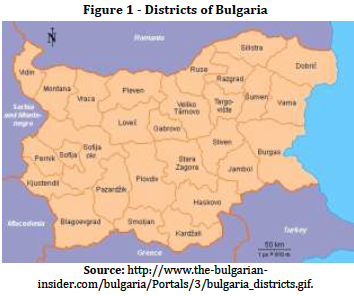
Studying the processes in tourism in Bulgaria, Dimitrov (2013b) noted that most of the Bulgarian rural municipalities located in the border regions are facing the necessity to develop its tourism potential. Nevertheless, the positive effect of the tourism industry for the local development (Ganchev & Nikolov, 2013a) in the Bulgarian part of the Greece-Bulgaria cross-border region can be easily seen in the Blagoevgrad and the Smolyan region where the existing skiing tourism centres of Bansko and Pamporovo have contributed also to the development of rural tourism, ecotourism and spa and wellness tourism. The Blagoevgrad district, the Smolyan and the Haskovo districts tourism resources for spa and wellness tourism in Sandanski, Ognyanovo, Devin and Haskovski mineralni bani are also a major factor that provokes tourists interests for the alternative forms of tourism as well. On the other hand, Kardjali district is well known as cultural tourism destination. However, each of these regions has its traditions in organizing festival and special events.
Assuming that local festivals can be classified as: Folklore festivals (one of the most common types, based on folk dance and music; we may add storytelling festivals here); Food/culinary festivals (events that have food as their central theme); Festivals dedicated to local agricultural products (with topic on the agriculture or on traditional food (meals prepared from the product); Festivals of traditional crafts (focused on crafts as a whole, or on a particular craft); Festivals on traditional rites / rituals; Festivals on gifts of nature/natural resources (these include herb festivals, festivals of wild plants, etc.); Festivals based on cultural / historical heritage (tangible and intangible) - a distribution of festivals according to their central theme was made for the study area (Figure 2). For this purpose, information has been obtained through extensive internet research on materials available for the four regions; surveys on the designated project target groups (local community, local businesses, organizers) and interviews. At this stage the secondary data collection method was applied, using the official sites of local authorities, the official site of the Ministry of Culture of Bulgaria, and the Bulgarian specialized web site for cultural events http://www.sabori.bg/.
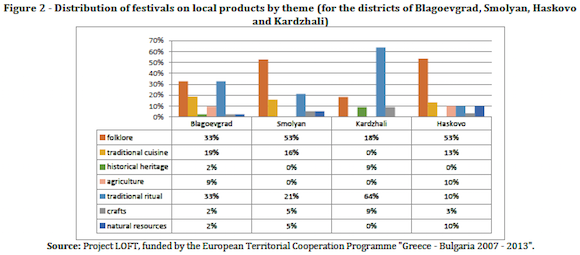
In the four Bulgarian administrative districts there are festivals on local products of all seven types; yet the prevalence of folklore once is obvious. In addition, even if its not the central theme, folk music and/or dances are a key component of each of the events organized in the regions under review.
In the district of Blagoevgrad, the most numerous types of festivals are the folklore ones and the events that represent a traditional ritual or celebration (each of them holding a share of 33%). Some of the latter are not festivals in the strictest sense of the term, but have been included in the study for two reasons: 1) they are public events that involve a considerable part of the local community, and 2) they hold significant potential for attracting tourists. The two rituals that are best presented not only in this region, but also in the other three are Mummers games (Kukeri), and Trifon Zarezan (a holiday, connected to ritual trimming of vines). Festivals on traditional cuisine form 19% of the total number, while agricultural, historical, natural resources and crafts events are very poorly represented (2% each).
In the district of Smolyan more than half of the festivals on local products are dedicated to folk music and dances, which is quite natural, given the popularity of Rhodopean music and the fact that one of the best high schools for folk music (the one in Shiroka Laka) is located there. Traditional rituals are the central theme of 21% of the events in the district, followed by festivals on crafts and natural resources (5% each).
The district of Kardzhali shows a clear difference from the trend seen in the other three regions. The most numerous events are the ones based on traditional rituals (64% of the total number), followed by a significantly lower share of folklore festivals (18%), and an equal share of crafts and historical festivals (9% each). It is the district with the lowest absolute number of festivals on local products (only 12 identified in this study).
The administrative district of Haskovo continues the trend of folklore festivals being the most numerous group (53% of the total number). Festivals based on traditional cuisine, agricultural products, traditional rituals and natural resources are almost equally presented (a share of about 10% for each of them), and there is no event festival dedicated to the historical heritage of the region. The total number of festivals on local products in the district included in this study is 31.
In this line of thought, heading towards the goal of the study - to access the cultural awareness among all groups involved in to the local festivals organizations and participation - the significant basis on which the festivals in the region were organized is shown on Figure 3. The importance of predefined variables was assessed by using a 4-point Likert scale ranging from 1 (not important) to 4 (very important).
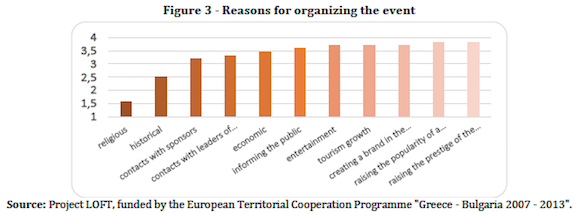
The reasons that play the least important role in organizing festivals on local products are the ones related to history and religion. In a second group of reasons that have relatively higher significance it can be identified those related to making contacts (with advertisers and sponsors, as well as public opinion leaders), and economic factors. The most important role in motivation is played by promotion (of both place and product), attracting tourists, creating a brand, and last but not least - providing entertainment.
The results once again show the major role that tourism plays in the organization of festivals and other special events. While only a few decades ago cultural institutions focused their attention on the preservation and promotion of local culture, today an important part of their motives is related to the increase of tourism flow in the destination. The above mentioned goals, however, are not always fully achieved (Figure 4).
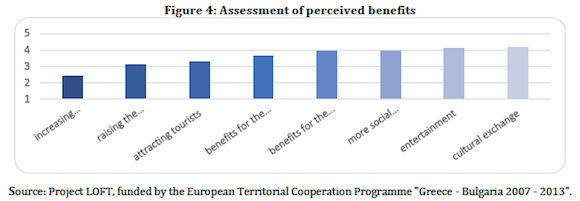
In order to assess perceived benefits, a Likert scale ranging from "Poor" (1) to "Excellent" (5) is applied. The results lead to the discovery that organizers did not achieve their goal according to two of their festival organizing motives: attracting tourists and promoting local production - they were assessed below average. The lowest evaluated benefit was increase of municipal revenues, which is somewhat understandable, since they are not among the important reasons for holding a festival for local products. Benefits associated with local businesses and the local communities are higher than average, but still do not reach a very good assessment. The provided entertainment and the possibility for cultural interactions are the top ranking benefits according to organizers.
Moreover, the festival activities scope was established. The results suggest that 64% of the respondents had held between two and five events related to local culture annually and a significantly lower share - 34% of all respondents respectively held over 4 festivals. The territorial scope of the attracted participants and visitors on the basis of the responses of the targeted question is depicted in Figure 5.
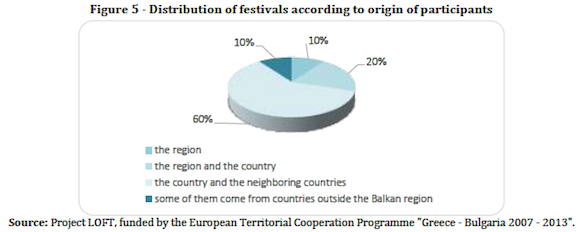
More than half of the organizers (60%) managed to attract both local and participants from coterminous countries. 20% of the events feature participants from the country, and a relatively small share of events re held only with participants from the region (10%). However, the share of those that attract participants from outside the Balkan region is quite small- only 10%.
Of particular interest are the answers given by the respondents in relation to the authenticity of the organized events (Figure 6).
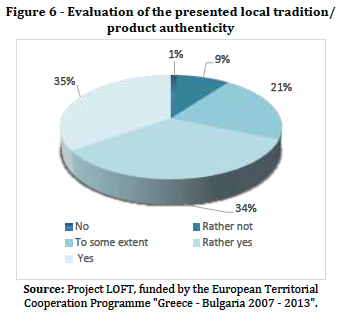
Most of the respondents – 35.81% consider that the main benefits from holding local festivals/ fairs are that they preserve and popularize the local traditions and customs and contribute to a great extent to the tourism development in the region – 28.38 %. Hardly 0.23 % of the respondents think that the organization of local events can cause environmental pollution. The number of responses is bigger than the number of respondents because respondents have given more than one answer. 33.33% of the respondents believe that the festivals/fairs conducted present sufficiently authentically the traditions/local products in the region, 29.03% gave a positive answer, 20.43% answered with rather yes, 10.75% answered with rather no, and 6.45% are adamant that the events do not provide an authentic representation of the products and traditions (Figure 7).
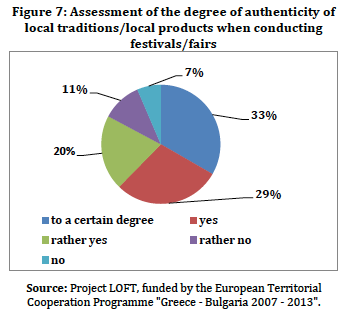
Overall, the results of the study can be summarized as follows:
- The main reasons for organizing a festival for local products / traditions are associated with improving locations image, promoting local products and traditions and supporting tourism activities thus raising the local cultural awareness. The entertainment aspect is of significant importance for organizers, participants and respectively for tourists.
- At the same time, respondents assessed relatively low the results achieved in terms of attracting tourists and promoting local business. The exchange of experiences and culture, and entertainment were stated as benefits from holding the event. While the majority of the organizers manage to attract foreign participants, visitors of the events are mainly from the country, and more than a quarter of all visitors are residents, their relatives/friends and residents of nearby settlements.
- The main obstructions that organizers are facing are related to funds scarcity and insufficient or ineffective advertising. In this regard, organizers should be aware and public and state administration should ease their axes to the related European operational programs.
- More than one third of respondents feel they do not present local traditions and products in an authentic way. Therefore, this could lead to an undesirable level of commoditization and as a result lower the quality of the event.
- All traditional celebrations which include the participation of the whole community are potentially suitable for staging a festival and attracting tourists. Special attention should however be paid to preserving their authenticity.
- The quality and uniqueness of a festival are both of great importance in the development of successful festival tourism, especially with the steady growth of festivals worldwide (Arnold, 2001; Gursoy, Kim, & Uysal, 2004). As a defence mechanism to the complexity of the modern society in which social relations are either falling apart or weakening rural areas chosen as vacation destination seem to offer the possibility for socializing, finding community identity and at the same time raising communitys cultural awareness. Thus, people are seeking friendly, genuine relationships, true and original experience, roots. In the same time, it is important to point that in order to improve community support, awareness strategies should be implemented to inform the community on possible benefits and how the costs of the event can be minimized (Loots, Ellis & Slabbert, 2012).
- Consequently, studying cultural tourism segment and its intangible heritage component – more specifically the local festivals – leads us to the conclusion that rural settlements are places where tourist can search, find or at least to compensate their lost identity. The image of the province as the mother of all traditions where one can find ones origin and all that honors the national character and culture in order to satisfy ones social demand for cultural identity.
- Heritage, whether tangible or intangible must be associated with nations cultural identity, as a distinguished feature of a local group. Heritage can be perceived as subjective due to the fact that is linked to a collective social memory. Social memory being a nations common legacy contains its cultural and social identity by dint of ritualized practices. Common cultural heritage appears as a ritual code (Bessière, 1998).
5. Conclusion
Tourism as a world culture phenomenon furthers the discovery of various aspects and manifestations of culture (Filipova, 2008). Cultural identity of a region consequently originates without a reasonable doubt from regions cultural heritage – tangible and intangible. The heritage is well kept and century long practiced customs, traditions and believes which did shape locals perception of the world, the surrounding reality, the others and themselves. And thats why tourist do travel around the world in order to discover attractive destinations – to get aquatinted with others people culture, traditions, nature, etc. To that reason culture, cultural identity, and cultural heritage do boost tourist destination attractiveness and are of a huge importance when new tourist flows, market, niche must be acquired.
Contemporary tourists are more and more looking for true experiences, for meeting and getting to know other people and other cultures. Implementing that, tourism destinations will need to adapt to new trends and develop a quality offer promoting local cultures and traditions and paying attention to sustainable aspects of preservation of the heritage, of the landscape, of the local culture. Thus made observations have their expression in connection with the Bulgaria South regions – the cross-border territory of Greece and Bulgaria, in an attempt to combine efforts to attract tourists, but also with the aim to ensure economic prosperity for local communities. Regarding to that, for the studded area of cultural awareness should be the main attention focus for all the stakeholders. Local business, local festivals and special events organizers as well as local communities should be aware of their cultural potential and tradition legacy just to stand together in order to guide tourism development and its specialized forms that will bear their intended positive effect of simultaneous increases in quality of life and preservation of inherited. The festival organizers especially should consider that it is imperative to understand tourist motivations for attending festivals in order to conduct effective festival planning and achieve a more productive festival marketing position and marketing strategy (Kitterlin and Yoo, 2014).
They should be expected also to have a constant desire to improve the cultural awareness form of local traditions and festival tourism is a suitable approach to achieve that goal. Mainly because the development of festival tourism stimulates jobs and income and the global picture shows a permanent competition between countries, regions and destinations in order to attract tourist flows and inward investment. On the other hand, by selecting the types of events the organizers have the opportunity to add their own cultural values to the festival vitalizing in such way local culture and local traditions.
References
Arnold, N. (2001). Festival tourism: recognizing the challenges – linking multiple pathways between global villages of the new century. In B. Faulkner, G. Moscardo, & E. Laws (Eds.), Tourism in the 21st century: Lessons from experience (pp. 130–162). London: Continuum. [ Links ]
Bessière, J. (1998). Local development and heritage: traditional food and cuisine as tourist attractions in rural areas. Sociologia Ruralis, 38, 21-34. doi: 10.1111/1467-9523.00061. [ Links ]
Borodako, K., Berbeka, J., Klimek, K., Niemczyk, A., & Seweryn, R. (2012). The changes of the meeting industry in Krakow in the context of the global crisis. Tourism & Management Studies, (7), 149-157. [ Links ]
Boo, S. & Busser, J. (2006). Impact analysis of a tourism festival on tourists destination images. Event Management, 9(4), 223-237. [ Links ]
Crompton, J.L., Lee, S. & Shuster, T.S. (2001). A guide for undertaking economic impact studies: the Springfest example. Journal of Travel Research, 40(1), 79–87. [ Links ]
Crouch, D., Aronsson, L., & Wahlström, L. (2001). Tourist encounters. Tourist Studies, 1(3), 253-270. Retrived August 15, 2014 from http://tou.sagepub.com/content/1/3/253.abstract [ Links ]
Derrett, R. (2003). Making sense of how festivals demonstrate a communitys sense of place. Event Management, 8(1), 49-58. [ Links ]
Dimitrov, P. (2013a). Forcasting the number of tourist arrivals in Southwest Bulgaria. Book of Abstract of TMS Algarve 2013 – Tourism & Management Studies International Conference. Faro, Portugal: University of Algarve. ISBN 978-989-8472-36-6. [ Links ]
Dimitrov, P. (2013b). Long-run forecasting of the number of the ecotourism arrivals in the municipality of Stambolovo, Bulgaria. Tourism & Management Studies, 9(1), 41-47. [ Links ]
Dimitrov, P. (2012). Long-term forecasting of the spa and wellness subsector of the Bulgarian tourism industry. Tourism & Management Studies, (7), 140-148. [ Links ]
Dwyer, L., Forsyth, P. & Spurr, R. (2005). Estimating the impacts of special events on an economy. Journal of Travel Research, 43(4), 351–359. [ Links ]
Edensor, T. (2001). Performing tourism, staging tourism: (re)producing tourist space and practice. Tourist Studies, 1, 59-81. [ Links ]
Felsenstein, D. & Fleischer, A. (2003). Local festivals and tourism promotion: the role of public assistance and visitor expenditure. Journal of Travel Research 41(4), 385-392. [ Links ]
Filipova, M. (2010). Peculiarities of project planning in tourism. Perspectives of innovations, economics and business. PIEB, 1(4), 57-59. [ Links ]
Filipova, M. (2008). Challenges before the achievement of a sustainable cultural tourism. Tourism and Hospitality Management, 14(2), 311-322. [ Links ]
Formica, S. & Uysal, M. (1996). A market segmentation of festival visitors: Umbria Jazz Festival in Italy. Festival Management and Event Tourism, 3(1), 175-82. [ Links ]
Ganchev, G. & Nikolov, C. (2013). Macroeconomic development and the tourism sector in Bulgaria: can tourism go against the cycle? Book of Abstracts of the TMS Algarve 2013 – Tourism & Management Studies International Conference. Faro, Portugal: University of Algarve. ISBN 978-989-8472-36-6. [ Links ]
Getz, D. (2007). Event studies: theory, research and policy for planned events. Oxford UK: Elsevier. [ Links ]
Getz, D. (2008). Event tourism: definition, evolution and research. Tourism Management, 29(3), 403-428. [ Links ]
Gibson, C. & Kong, L. (2005). Cultural economy: a critical review. Progress in Human Geography, 29(5), 541-61. [ Links ]
Gursoy, D., Kim, K., & Uysal, M. (2004). Perceived impacts of festivals and special events by organizers: an extension and validation. Tourism Management, 25(2), 171–181. [ Links ]
Huang, J.Z., Li, M. & Cai, L.A. (2010). A model of community-based festival image. International Journal of Hospitality Management, 29(2), 254–260. [ Links ]
Jeong, S. & Santos, C. (2004). Cultural politics and contested place identity. Annals of Tourism Research, 31(3), 640–656. [ Links ]
Kim, C., Scott, D., Thigpen, J. & Kim, S. (1998). Economic impacts of a birding festival. Journal of Festival Management and Event Tourism, 5(1-2), 51–58. [ Links ]
Kitterlin, M., & Yoo, M. (2014). Festival motivation and loyalty factors. Encontros Científicos-Tourism & Management Studies, 10(1), 119-126. [ Links ]
Klaic, D. (2002). Challenges and strategies in festivals: challenges of growth, distinction, support base and internationalization. Tartu: Department of Culture of the Tartu City Government. [ Links ]
Kostopoulou, S., Vagionis, N., and Kourkouridis, D. (2013) Cultural Festivals and Regional Economic Development: Perceptions of Key interest Groups. In A. Matias, P. Nijkamp, M. Sarmento (eds.) Quantitative Methods in Tourism Economics, Advances in Tourism Economics Series, Physica-Verlag. A Springer Company, Heidelberg, 175-194. [ Links ]
Kotler, P., Haider, D. H. & Rein, I. (1993) Marketing places: attracting investment, industry, and tourism to cities, states, and nations. The Free Press: New York. [ Links ]
Kyurova, V. & Dimitrova, R. (2013). State and trends in the development of entrepreneurship in the South-West Planning Region of Bulgaria. Journal of Management and Marketing, 1, 42-53. [ Links ]
Lade, C. & Jackson, J. (2004). Key success factors in regional festivals: Some Australian experiences. Event Management, 9(1-2), 1-11. [ Links ]
Loots, I., Ellis, S., & Slabbert, E. (2012). Factors predicting community support: The case of a South African arts festival. Tourism & Management Studies, (7), 121-130. [ Links ]
Maurin, F. (2003). Still and again: Whither Festivals?. Contemporary Theatre Review, 13(4), 5-11. [ Links ]
Mehmetoglu, M., & Ellingsen, K. A. (2005). Do small-scale festivals adopt market orientation as a management philosophy?. Event Management, 9(3), 119-132. [ Links ]
McCann, E. (2002). The cultural politics of local economic development: meaning-making, place-making, and the urban policy process. Geoforum, 33, 385-98. [ Links ]
OSullivan, D. & Jackson, M. (2002). Festival tourism: a contributor to sustainable local economic development? Journal of Sustainable Tourism, 10(4), 325–342. [ Links ]
Thrane, C. (2002). Jazz festival visitors and their expenditures: linking spending patterns to musical interest. Journal of Travel Research, 40(3), 281–286. [ Links ]
Uzunova, D. (2013). Cultural view of the town of Plovdiv, Bulgaria, as a tourist destination. Book of Abstract of the TMS Algarve 2013 – Tourism & Management Studies International Conference. Faro, Portugal: University of Algarve. ISBN 978-989-8472-36-6. [ Links ]
Van de Wagen, L. (2005) Event management: For tourism, cultural, business and sporting events (2nd ed.). Frenchs Forest: Pearson Education Australia. [ Links ]
Article
history:
Received: 15 May 2014
Accepted: 18 November 2014














